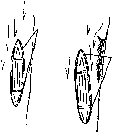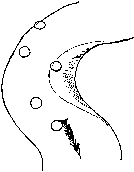Piloting a Boat
|
Reading Skills Most Alaskans live or hunt on rivers. On almost every Alaskan river there are a few people who really know how to pilot a boat. They are river scientists who operate by basic principles the rest of us need to learn. Once we are able to read a book, we have the skills to read other books. Once we are able to read a certain river, we discover that we have the skills to read other rivers also. The signs and patterns are common to all rivers. Repeated travel helps us learn the river better. However, a good pilot can travel a completely strange river and sight read it the same way you would read a new book. With identical boats, an experienced pilot can go from one place to another faster than an inexperienced pilot. How is this possible? He understands the forces working for and against his boat, for and against the river. |
||
|
Three Main Forces
The river channel is often deeper on the outside of bends. On the inside of the bends, the current is slack. Look at the following drawings of a typical bend in a swift river. The two forces, gravity and inertia, are sometimes working together and sometimes competing. In the first drawing, the slope of the river isn’t too steep, so inertia carries most of the water to the outside of the bend, creating a swift deep channel there. 1. In the second drawing, the water is flowing down a steep slope. Inertia is working to carry water to the outside of the bend, but the drop is so great, gravity forces the water to fall to the shortest distance which is on the inside of the bend. Gravity overrides inertia. If the pilot understands these forces and how they interact, he can understand almost all river situations in Alaska. |
|||
 |
When the current slows, and its ability to carry sediment also decreases, an island or sandbar forms in the middle of the river. The channel goes to either or both sides of the island. Other islands are formed when the river channel erodes its way through the banks, separating large land segments. |
||
|
Pilot’s Priorities As the pilot looks at the river while going upstream, the priorities are:
The pilot looks at the stretch of water in front of the boat. Math and science blur together as decisions are continually made figuring the best path to travel. Where are the snags, eddies, slack current, straightest paths, and shallowest waters? |
|||
 |
The Current Varies The current is slower close to the riverbank than in the middle of the river. Friction with the riverbank and bottom of the river in the shallow places slows the current. If you measure the current across a river, you will find that it varies tremendously from place to place. Salmon are aware of this and travel the path of least resistance in their journey upstream. They prefer the shallows at night because they feel safe, but swim on the bottom in the middle of the river during daylight in order to avoid detection. The current might be six miles per hour (mph) in the middle, eight mph five feet from the cutbank, two to three mph right against the bank, two mph on the sandbar side of the river in the shallow places, and minus two mph in the eddy. A good river pilot takes advantage of all slack current. Against a cutbank, the water swirls backwards due to friction with the bank. Sometimes the stumps and brush keep a good pilot away from those back currents, but traveling close to the cutbank adds several miles per hour to the boat’s speed as it goes upstream.
Eddies The water swirls backwards in eddies. The current is actually going in the opposite direction from the rest of the river. Good pilots search for eddies. Fish rest in eddies and use the current to assist in the upstream effort. The opposing currents hold a net in perfect position to catch the fish as they head upstream. Because of this, good pilots watch out for nets as they travel the eddies. The current swirls in low pressure areas behind rocks and snags. A good pilot enters a place with slack current behind a rock, gains speed, and shoots out before crashing into the rock. In very shallow water, an experienced pilot knows that the water is deeper right beside snags and rocks, as the water intended for the snag is diverted aside, creating a mini-channel deep enough for the boat. |
||
|
Efficiency A pilot must decide which path upriver gives the least resistance. Obviously it isn’t worth crossing a wide river to get a little help from an eddy. There is a constant give and take in this regard, constant decision-making by the pilot. Ground Effect A boat lifts when traveling in shallow water. The pilot hears the motor speed up as the boat lifts. The shallower the water is, the more lift there is, but there is also a greater the chance of hitting bottom. This is why the pilot pays close attention to the sound of the motor. When the boat is in deep water, the water is pushed down and away from the bottom of the boat. The boat sinks to some extent. In shallow water, the water is pushed downward and away from the bottom of the boat, but it cannot move downward because the bottom of the river is solid. The boat pushes down. The water and bottom push up. |
|||
WavesSome waves are caused by the current moving around underwater obstructions. This is particularly distressing when rafting logs or firewood. The pilot feels totally safe on one section of the river, rounds a bend, and gets into huge whitecaps that threaten the safety of the boat and raft. Wind generated waves are smaller against the bank. Why is this? The current against the bank is slower than it is in the middle of the river, and therefore the combined velocities of the wind and water is less. The waves in the middle are bigger because the combined velocities of the unobstructed wind and current going against each other are greater. |
|||
|
Bow down— Bow up—waves
|
FrictionAnother consideration of piloting a boat concerns the friction of the boat against the water. The more surface that is in contact with the water, the more friction there is. A boat that has the bow too low will have a lot of surface to create friction. A boat that has the bow too high will plow the water, and pound in the waves. A good pilot adjusts the angle of the boat by shifting the load and changing the tilt on the engine. |
||
Trapped Air |
|||
Reading the RiverIt is very hard to read a river when it is windy. Whatever sign might be presented by the snags and rocks is masked by the waves from the wind. It is like trying to read a book in the dark. It is also very hard to read a river when there is little or no current. Some of my greatest disasters have been on windy days or in dead water. When there is adequate current, shallows, rocks, and stumps all give sign of their presence and are easy to read.
|
|||
|
|||
Travel at DuskGood pilots learn to protect their night vision, as it is quite easy to read the channel in twilight after the sun has gone down. The glare from the surface of the water highlights all of the signs the pilot is looking for. It takes most people fifteen to twenty minutes to develop night vision. Artificial lights are a hindrance unless they are extremely bright. The glare from the water makes visibility worse and ruins night vision. It is important to have running lights, not for the pilot’s vision, but so boats will not collide. Years ago a boatload of people ran over a swimming moose at night. Five people drowned. Travel in full darkness is not wise at all. |
|||
 |
Activities
|
||
|
Plywood
not.
Plywood.
|
|||
 |
Student Response
|
||
 |
Math
|

 There
are three main forces working on the water in a river.
There
are three main forces working on the water in a river.
 2.
2. 
 Islands
Formed
Islands
Formed
 Using
Rocks and Snags
Using
Rocks and Snags Surface
waves are created by wind blowing over the water’s surface.
When the current and wind are moving in the same direction, the
waves are small. When the current and waves go against each other,
the combined velocities can be great, causing large waves. This
explains why some sections in a river can have no waves, and another
section of the same bend can have whitecaps. On one section of the
river, the wind blows directly against the current. On another section
it is crosswise. In another section, the wind is blowing with the
current.
Surface
waves are created by wind blowing over the water’s surface.
When the current and wind are moving in the same direction, the
waves are small. When the current and waves go against each other,
the combined velocities can be great, causing large waves. This
explains why some sections in a river can have no waves, and another
section of the same bend can have whitecaps. On one section of the
river, the wind blows directly against the current. On another section
it is crosswise. In another section, the wind is blowing with the
current.


 Waves
trap air under the boat. The air, once under the boat, becomes flat
bubbles that greatly reduce the friction with the water. This effect
is very noticeable when coming from a small creek onto a larger
river on a windy day. The boat accelerates when it hits the small
choppy waves and breaks free from the drag of smooth water. The
boat decelerates considerably when it comes from a river with small
choppy waves and enters a smooth creek.
Waves
trap air under the boat. The air, once under the boat, becomes flat
bubbles that greatly reduce the friction with the water. This effect
is very noticeable when coming from a small creek onto a larger
river on a windy day. The boat accelerates when it hits the small
choppy waves and breaks free from the drag of smooth water. The
boat decelerates considerably when it comes from a river with small
choppy waves and enters a smooth creek.


 Upstream
vs Downstream
Upstream
vs Downstream
 What are the three main forces working on the water in a river?
What are the three main forces working on the water in a river?